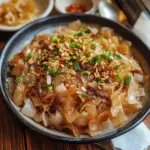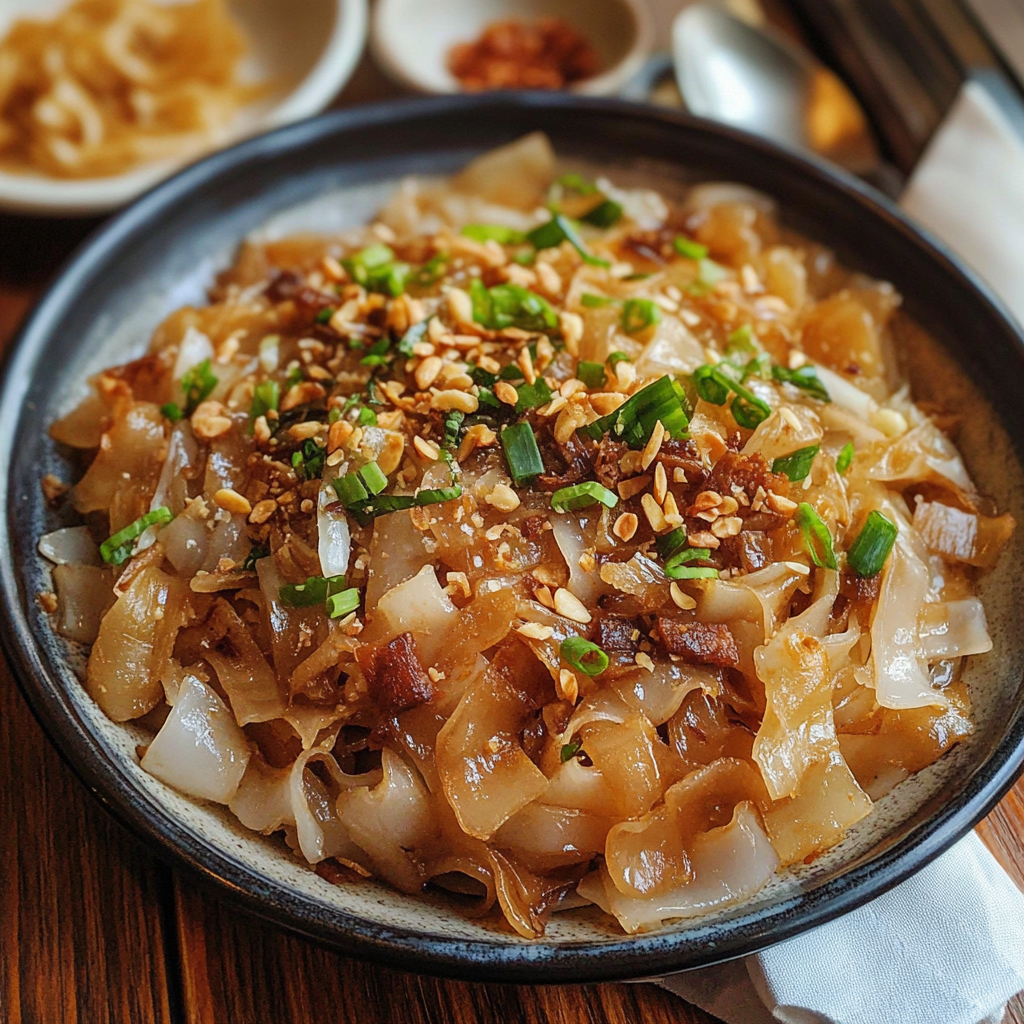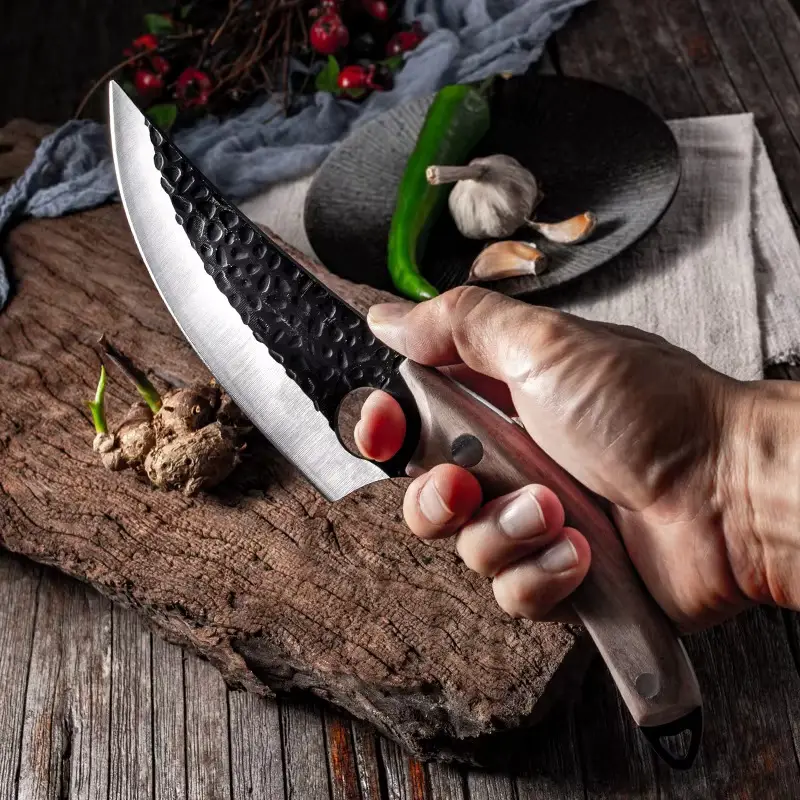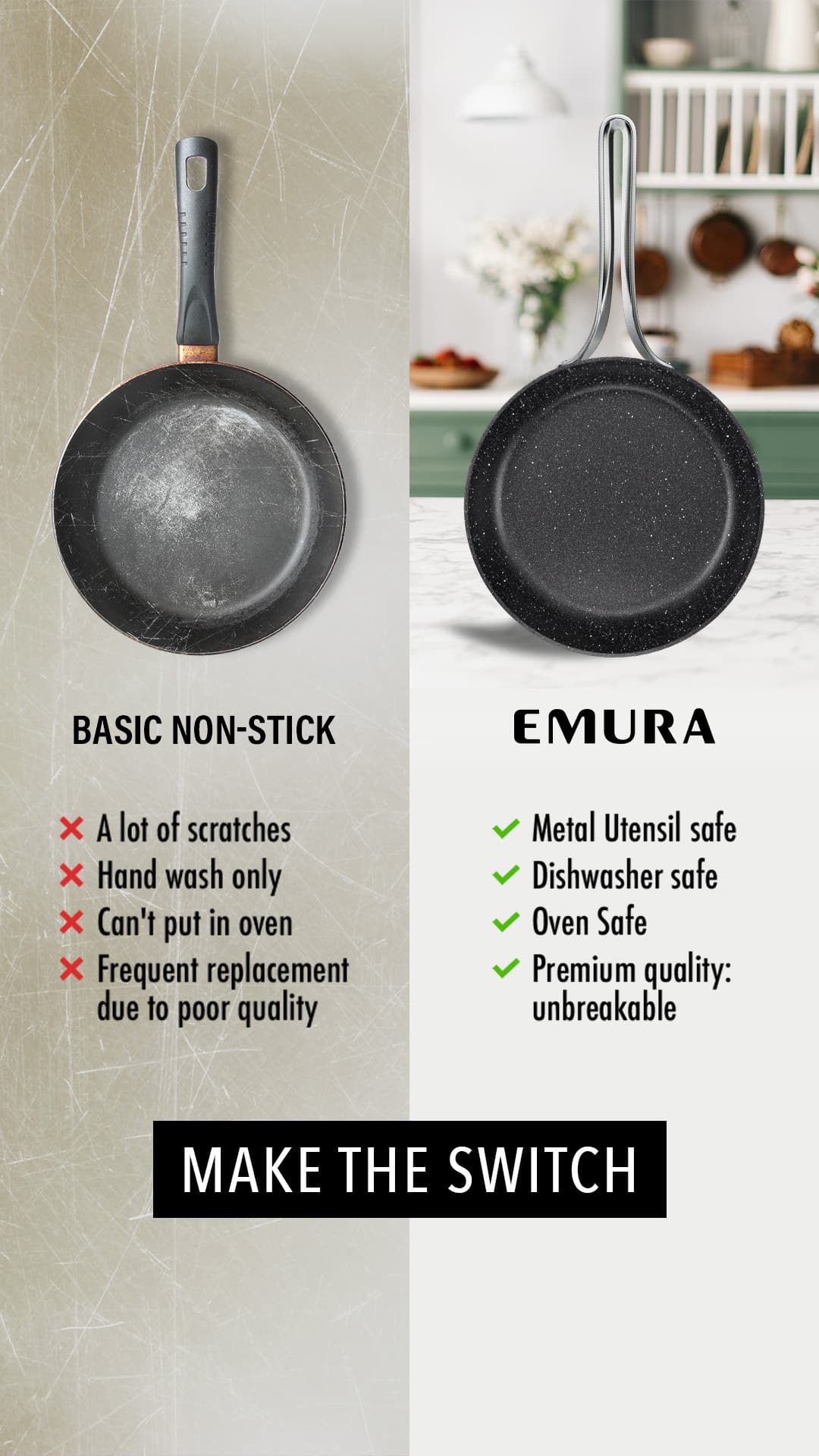Vietnamese cuisine is famous for its delicate yet flavorful noodle dishes, and at the heart of many of them lies the soft, chewy, and slightly translucent Vietnamese flat rice noodles, known as bánh phở. These noodles are the foundation of classic Vietnamese dishes like Phở (Vietnamese beef noodle soup), Bún Thịt Nướng (grilled pork noodle bowl), and Phở Xào (stir-fried flat noodles).
Making homemade rice noodles from scratch is surprisingly easy and requires only a few ingredients: rice flour, tapioca starch, water, and a little patience. The result? Fresh, silky noodles with a tender bite that soak up flavors beautifully.
If you don’t want to make them from scratch, store-bought fresh or dried rice noodles can be just as delicious. Whether you plan to use them in a steaming bowl of pho, a flavorful stir-fry, or a fresh noodle salad, this guide will walk you through how to make, cook, and use Vietnamese flat rice noodles like a pro!
Why You’ll Love Vietnamese Flat Rice Noodles
1. Naturally Gluten-Free & Light
Made with only rice flour and starch, these noodles are naturally gluten-free, making them a great option for those with dietary restrictions.
2. Extremely Versatile
Vietnamese flat rice noodles can be used in soups, stir-fries, noodle salads, or even spring rolls. You can swap them in for many other types of Asian noodles for a softer, lighter texture.
3. Better Than Store-Bought
While store-bought rice noodles are convenient, homemade ones have a freshness and softness that can’t be beaten. Plus, they don’t break apart as easily when stir-fried.
4. Great for Meal Prep
You can make a large batch, store them in the fridge, and use them throughout the week for quick and delicious meals.
Preparation Time and Yield
- Prep Time: 10 minutes
- Cook Time: 30 minutes
- Resting Time: 1 hour
- Total Time: 1 hour 40 minutes
- Yield: 4 servings
Nutritional Information (Per Serving)
- Calories: 220 kcal
- Carbohydrates: 48g
- Protein: 2g
- Fat: 0g
- Fiber: 1g
- Sugar: 0g
Ingredients for Homemade Vietnamese Flat Rice Noodles
For the Noodle Batter:
- 1 ½ cups rice flour
- ½ cup tapioca starch (or cornstarch for a firmer texture)
- 2 ½ cups water
- ½ teaspoon salt
- 1 teaspoon vegetable oil
For Cooking the Noodles:
- 1 tablespoon oil (for brushing the steaming tray or pan)
- 1 pot of boiling water (for steaming)
Step-by-Step Instructions
for Making Vietnamese Flat Rice Noodles
Step 1: Prepare the Noodle Batter
- In a large mixing bowl, combine rice flour, tapioca starch, salt, and water. Stir well until smooth and lump-free.
- Add vegetable oil and whisk again. Let the batter rest for at least 30 minutes to allow the flour to fully hydrate.
Step 2: Steam the Noodle Sheets
- Bring a large pot of water to a simmer and place a flat steaming tray (or large nonstick baking sheet) over the steam.
- Lightly brush the tray with oil to prevent sticking.
- Pour a thin layer of batter onto the tray and swirl to spread evenly. Cover and steam for 3-4 minutes until set. The noodles should look translucent when done.
Step 3: Cool & Cut the Noodles
- Carefully peel off the noodle sheet and transfer it to a plate to cool.
- Repeat the process until all batter is used, stacking the noodle sheets on top of each other with a light layer of oil between them to prevent sticking.
- Once cool, use a sharp knife to cut into strips (½-inch for pho noodles, wider for stir-fry noodles).
Step 4: Store or Use the Noodles
- If not using immediately, store the noodles in an airtight container in the fridge for up to 3 days.
- To reheat, quickly dip in warm water before using in soups or stir-fries.
Ingredient Background
Vietnamese flat rice noodles, known as bánh phở, are an essential ingredient in many traditional Vietnamese dishes. Their chewy texture, neutral flavor, and ability to absorb sauces and broths make them incredibly versatile. Let’s take a closer look at the key components that make these noodles so special.
1. Rice Flour: The Base of the Noodles
Rice flour is the main ingredient, giving these noodles their smooth and slightly elastic texture. It’s naturally gluten-free, making these noodles perfect for those with gluten sensitivities.
2. Tapioca Starch: The Secret to Chewiness
Adding tapioca starch (or cornstarch) enhances the stretchiness and chewiness of the noodles, preventing them from becoming too brittle.
3. Water: Hydrating the Batter
Water controls the consistency of the batter, ensuring the right balance between firmness and softness in the noodles.
4. Oil: Preventing Stickiness
A small amount of oil in the batter (and between layers) helps prevent the noodles from sticking together when stacking them.
Technique Tips for the Best Vietnamese Flat Rice Noodles
1. Achieving the Right Batter Consistency
- The batter should be thin, like crepe batter—not too thick or too runny.
- If it’s too thick, add a little more water. If it’s too thin, mix in a bit more rice flour.
2. Steaming vs. Pan-Cooking the Noodles
- Steaming results in soft, silky noodles that are perfect for pho and stir-fries.
- Pan-cooking (like a thin pancake) creates firmer noodles that work well for noodle salads or rolls.
3. How to Prevent Noodles from Sticking
- Brush a thin layer of oil between each noodle sheet before stacking them.
- If using store-bought noodles, rinse them under cold water after cooking to stop them from clumping.
4. Cutting the Noodles Evenly
- Use a sharp knife or a pizza cutter for clean, even slices.
- If the noodles are sticking, dust them lightly with rice flour before cutting.
5. Reheating Without Losing Texture
- Briefly dip the noodles in hot water (for soups) or stir-fry them with a bit of oil to restore their soft, chewy consistency.
Alternative Presentation Ideas
Vietnamese flat rice noodles are incredibly versatile! Here are some creative ways to serve them:
1. Spicy Lemongrass Stir-Fry (Phở Xào Sả Ớt)
Stir-fry the noodles with sautéed lemongrass, garlic, chili, and a protein of choice (beef, shrimp, or tofu) for a fragrant, spicy dish.
2. Vietnamese Rice Noodle Rolls (Bánh Cuốn Style)
Instead of cutting the steamed noodle sheets, use them as wrappers, filling them with ground pork, mushrooms, and herbs.
3. Rice Noodle Soup with Coconut Curry Broth
Pair the noodles with a rich, creamy coconut curry broth, adding chicken, shrimp, and vegetables for a flavorful twist on traditional pho.
4. Crispy Pan-Fried Rice Noodles
Pan-fry the noodles until crispy and golden, then top with a savory stir-fry sauce for a crispy noodle dish similar to Vietnamese chow fun.
Freezing and Storing Vietnamese Flat Rice Noodles
Short-Term Storage (Refrigeration)
- Store fresh noodles in an airtight container in the fridge for up to 3 days.
- To reheat, dip in hot water for 30 seconds or steam briefly.
Freezing Instructions
- Fresh rice noodles don’t freeze well because they become brittle when thawed.
- If freezing, coat them in a thin layer of oil, store in an airtight container, and thaw by steaming rather than microwaving.
Healthier Twist Ideas
Want to make Vietnamese flat rice noodles even healthier? Try these modifications:
1. Use Brown Rice Flour for Whole-Grain Noodles
- Replace 50% of the white rice flour with brown rice flour for extra fiber and nutrients.
2. Reduce Starch for Lower-Carb Noodles
- Use less tapioca starch and increase rice flour slightly for a lower-carb option.
3. Add More Vegetables to Your Dishes
- When using rice noodles in stir-fries or soups, load up on bok choy, mushrooms, bell peppers, and bean sprouts for added nutrition.
Serving Suggestions for Events
These flat rice noodles are perfect for any occasion, whether it’s a quick weeknight meal or a special gathering.
1. Pho Night with Family & Friends
Set up a DIY pho bar with:
- Hot beef or chicken broth
- Cooked flat rice noodles
- A variety of toppings: bean sprouts, Thai basil, lime wedges, chili slices
- Serve with hoisin sauce and sriracha for customization.
2. Vietnamese Street Food Party
Make a selection of noodle dishes such as:
- Pho Xao (stir-fried rice noodles with beef)
- Bún thịt nướng (grilled pork noodle salad)
- Gỏi cuốn (fresh spring rolls with rice noodles)
3. Summer Noodle Salad Picnic
Toss the noodles with grilled shrimp, fresh herbs, cucumbers, and a tangy fish sauce dressing for a refreshing cold noodle dish.
How to Cook Store-Bought Flat Rice Noodles
If using dried rice noodles, follow these steps to cook them perfectly:
- Soak dried rice noodles in warm water for 30-40 minutes until softened but still firm.
- Bring a pot of water to a boil, then turn off the heat.
- Add the soaked noodles and let them sit in the hot water for 1-2 minutes, stirring gently.
- Drain and rinse with cold water to stop the cooking process. Toss with a little oil to prevent sticking.
Ways to Use Vietnamese Flat Rice Noodles
Now that you have perfect chewy, silky flat rice noodles, here are some amazing ways to use them:
1. Classic Vietnamese Pho (Phở Bò or Phở Gà)
- Use the noodles in a rich beef or chicken broth with fresh herbs, lime, and chili.
2. Stir-Fried Noodles (Phở Xào or Pad See Ew)
- Toss the noodles with soy sauce, garlic, vegetables, and beef, shrimp, or tofu for a quick, flavorful stir-fry.
3. Vietnamese Noodle Salad (Bún Thịt Nướng)
- Serve the noodles cold with grilled meat, fresh herbs, and a tangy fish sauce dressing.
4. Spring Rolls (Gỏi Cuốn)
- Use the noodles as a filling for fresh spring rolls, along with shrimp, herbs, and lettuce.
Storage and Freezing Tips
How to Store Fresh Rice Noodles
- Store in an airtight container in the fridge for up to 3 days.
- To reheat, dip in hot water for 30 seconds before serving.
Can You Freeze Rice Noodles?
- Homemade fresh rice noodles do not freeze well (they become brittle when thawed).
- If you must freeze them, coat them in a thin layer of oil, store in a sealed bag, and reheat by steaming.
Frequently Asked Questions (FAQs)
1. Can I use cornstarch instead of tapioca starch?
Yes! Cornstarch makes the noodles a little firmer, while tapioca starch gives them a softer, more elastic texture.
2. Why are my noodles breaking?
- If the batter is too thick, add a little more water.
- If overcooked, the noodles can become brittle—steam only until translucent.
3. What’s the best way to cut rice noodles?
Use a sharp knife or pizza cutter to cut them cleanly.
4. Can I make these noodles without a steamer?
Yes! You can use a nonstick pan on low heat with a lid to cook the batter like crepes.
5. Can I make brown rice noodles?
Yes! Substitute half of the rice flour with brown rice flour for a heartier, nuttier texture.
Conclusion
Vietnamese Flat Rice Noodles are silky, versatile, and incredibly easy to make at home. Whether you’re using them in pho, stir-fries, or fresh spring rolls, these homemade noodles bring authentic texture and freshness to every dish.
So why not give them a try? With just rice flour, water, and a bit of patience, you can enjoy fresh, chewy, restaurant-quality noodles in your own kitchen!
Print
Vietnamese Flat Rice Noodles (Bánh Phở Homemade & Stir-Fry Guide)
- Total Time: 1 hour 40
- Yield: 4 servings 1x
Ingredients
For the Noodle Batter:
- 1 ½ cups rice flour
- ½ cup tapioca starch (or cornstarch for a firmer texture)
- 2 ½ cups water
- ½ teaspoon salt
- 1 teaspoon vegetable oil
For Cooking the Noodles:
- 1 tablespoon oil (for brushing the steaming tray or pan)
- 1 pot of boiling water (for steaming)
Instructions
Step 1: Prepare the Noodle Batter
- In a large mixing bowl, combine rice flour, tapioca starch, salt, and water. Stir well until smooth and lump-free.
- Add vegetable oil and whisk again. Let the batter rest for at least 30 minutes to allow the flour to fully hydrate.
Step 2: Steam the Noodle Sheets
- Bring a large pot of water to a simmer and place a flat steaming tray (or large nonstick baking sheet) over the steam.
- Lightly brush the tray with oil to prevent sticking.
- Pour a thin layer of batter onto the tray and swirl to spread evenly. Cover and steam for 3-4 minutes until set. The noodles should look translucent when done.
Step 3: Cool & Cut the Noodles
- Carefully peel off the noodle sheet and transfer it to a plate to cool.
- Repeat the process until all batter is used, stacking the noodle sheets on top of each other with a light layer of oil between them to prevent sticking.
- Once cool, use a sharp knife to cut into strips (½-inch for pho noodles, wider for stir-fry noodles).
Step 4: Store or Use the Noodles
- If not using immediately, store the noodles in an airtight container in the fridge for up to 3 days.
- To reheat, quickly dip in warm water before using in soups or stir-fries.
- Prep Time: 10 minutes
- Resting Time: 1 hour
- Cook Time: 30 minutes
Nutrition
- Calories: 220
- Sugar: 0g
- Fat: 0g
- Carbohydrates: 48g
- Fiber: 1g
- Protein: 2g



